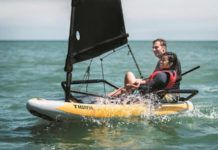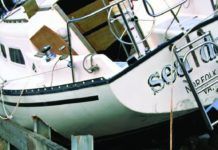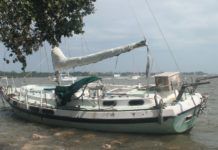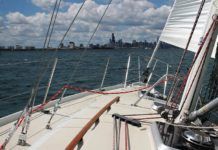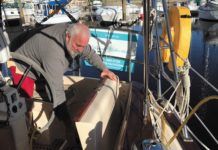MAIB Report Falls Short
Late last month, the United Kingdoms Marine Accident Investigation Board released its investigation report on the death of Simon Speirs, the 60-year-old sailor who drowned after falling overboard during the 2017-2018 Clipper Ventures Around the World Race. The biennial race, organized by legendary offshore sailor Sir Robin Knox Johnston, invites sailors to pay about $60,000 to compete in a nearly year-long race around the world on custom 70-foot offshore racing sloops. The race is also an advertising vehicle for corporate sponsors. The next race is set to begin in about two months.
The Sailing Skiff that Fits in a Locker
Sailing a cruising boat is many things-rewarding, sometimes adventurous, and often relaxing-but seldom viscerally fun, not in the way that a beach cat or performance dinghy saturates the senses and puts you in touch with the wind and waves. It doesn't communicate every ripple and puff, it doesn't thrill, and it doesn't allow you to push the edge. Its the difference between driving a Winnebago and riding a bicycle. For many of us, our love of sailing began with something fast and volatile, and by-and-by, we miss it dearly. And yet as much as wed like to strap a Laser or Hobie to the foredeck, thats not happening.
Fiberglass Boat Strength
Several years ago I heard a story about a boatbuilder who was demonstrating the toughness of their hull at a boat show booth by allowing passersby to wack a hammer at a sample fiberglass sandwich core panel. Each time, the hammer would impressively bounce back, leaving only a small dent. But then one dubious volunteer (an engineer, one presumes) took a turn, but this time with the hammer claw at the business end. The claw quickly pierced the thin laminate and lodged in the core, thus puncturing the myth of the indestructible hull.
4 Types of Pocket Cruisers
The recent release of Steve Wystrachs outstanding documentary film Manry at Sea about Robert Manry, the former copy editor who sailed across the Atlantic in a 13-foot sailboat, got me thinking again about the virtues of small cruising boats. In my view, there are at least four main types of pocket cruisers. Manrys modified lake boat fits somewhere in between the first two.
Fixing the Storm-Damaged Boat
With $655 million dollars marine vessel insurance claims from the 2017 hurricanes Harvey and Irma, there is no shortage of broken boats accumulating in salvage yards. The nations three big damaged boat liquidators - Certified Sales, Cooper Capital and U.S. Auctions are gradually thinning out their listings from Irma and Harvey, but Florence will surely bring a new crop. But just how salvageable are these boats?
Drawing the Line on Boat Design
A New Zealander greatly influenced by the traditional craft of the Pacific and Indian Oceans, famed multihull designer Ian Farrier understood that an enduring design goes through several evolutions. Proas, the small sailing craft of Micronesia that inspired his visionary folding trimaran design, presented a perfect example of this.
Deck Leaks, Mast Step Are Top Concerns
The Ericson 34-2 hull hand-laminated monocoque structure made from a single mold.
Selling Your Boat without a Broker
Im not anti-broker. Ive happily used agents buying and selling boats and houses. They serve a valuable function, bringing buyers and sellers together, managing the viewings for out-of-town and busy owners, and generally helping the transaction go smoothly. They can serve as go between during negotiations, inspections, and formalities. But they also represent a large expense in a transaction, generally 10 percent by default, though this may be negotiated lower (potentially with a reduction in service).
Flim-flam Artists Prey Upon Sellers and Buyers
You will get crank requests for information. The most dangerous are those offering to buy the boat sight unseen. For example, the person described below has not seen the boat perfect since I had not shown the boat and had only cleaned it of clutter that day. The most obvious protections are to meet face-to-face, and to accept payment by wire transfer or cash only, since cashiers checks can be counterfeit. Use the services of a documentation and title company for larger boats. If a cashiers check is the only practical means, do not release the property until the check has cleared.
What You Should Expect from a Boat Broker
If you decide to work with a broker, remember that you have options. A brokers fee is always 10 percent upon the sale of the boat, but some offer more services than others for the same price. Brokers asking you for funds up front should be immediately discounted.





































